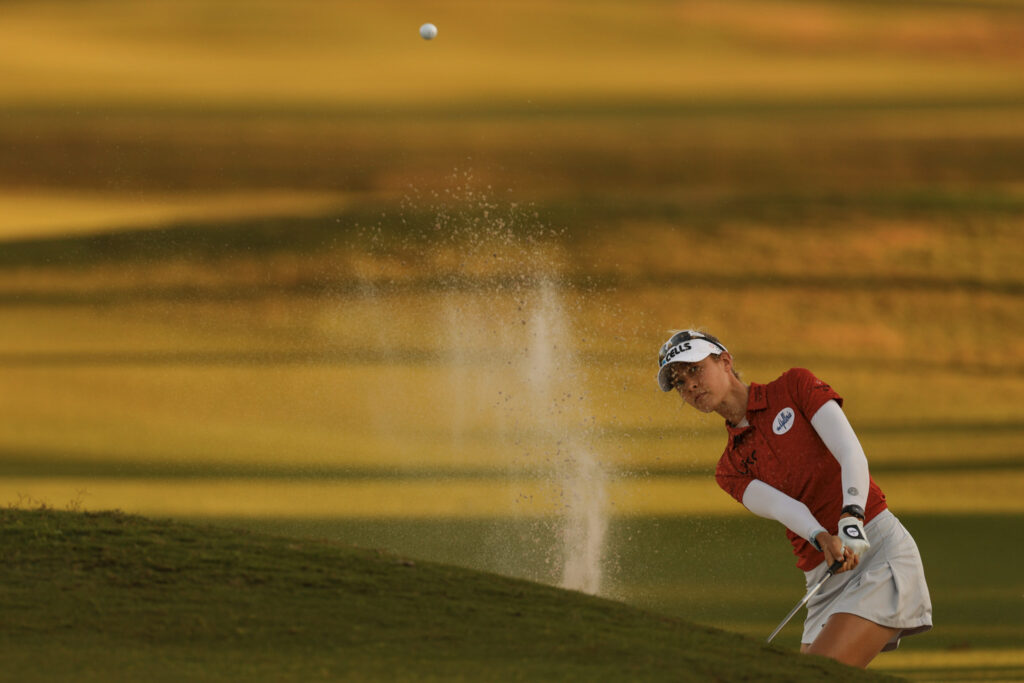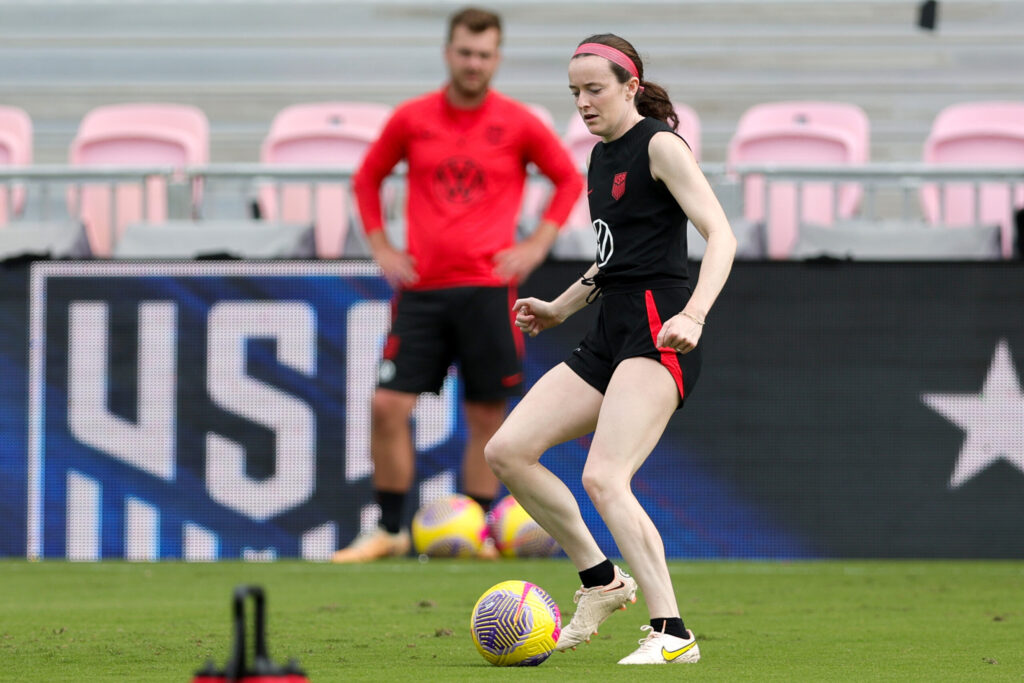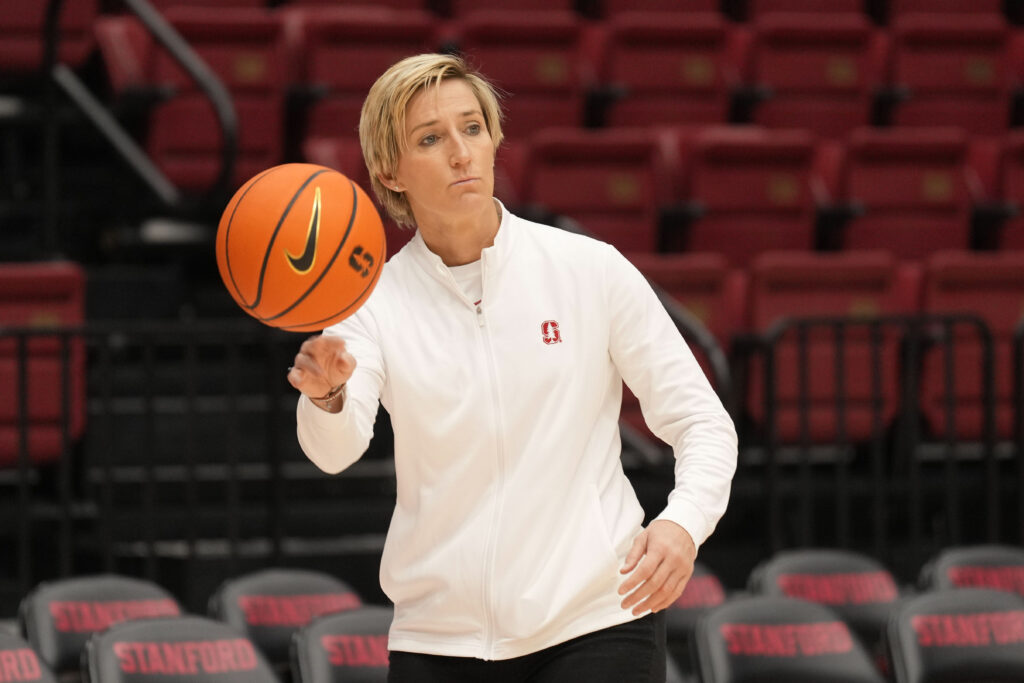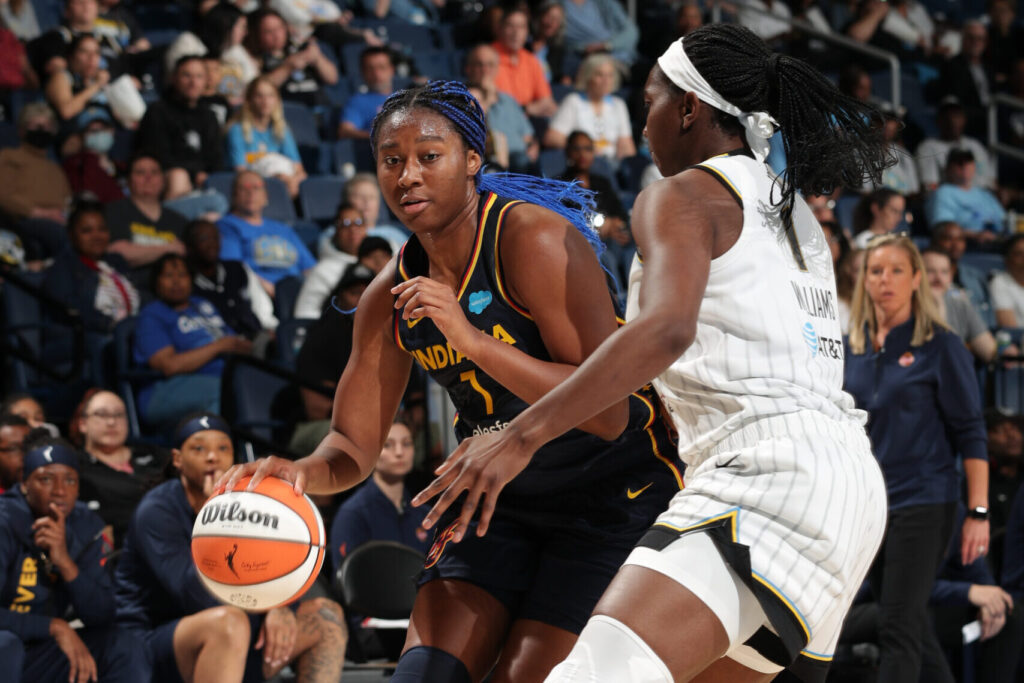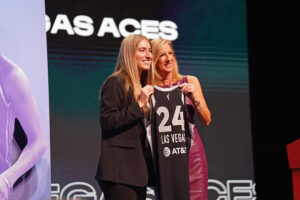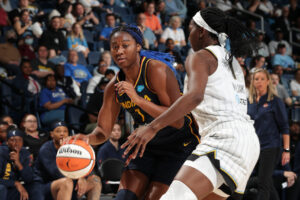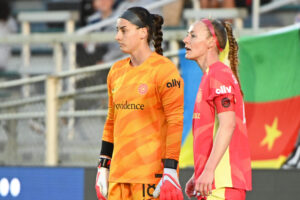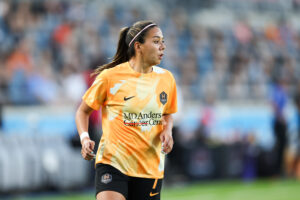As the LPGA Tour heads into the Chevron Championship this weekend, the first major tournament of the 2022 season, it’s as good a time as any to start following the action.
The first few months alone have produced a host of intriguing storylines. World No. 1 Jin Young Ko has scored 16 rounds in the 60s and 34 consecutive rounds under par after setting a record of 66 straight greens hit in regulation. Leona Maguire of Ireland and Nanna Koerstz Madsen of Denmark became the first players from their countries to win on the LPGA Tour.
If you’re looking for a primer on the LPGA as the season heats up, we have you covered.
Just Women’s Sports spoke with six Golf Channel commentators who have covered the LPGA for nearly 100 years combined, giving them a platform to serve as guides for the tour. They shared their favorite moments on air and what to watch for in the LPGA this year.
(Editor’s note: The following interviews have been lightly condensed for length and clarity.)
When watching the LPGA for the first time, what should a new fan be looking out for?
Paige Mackenzie: LPGA player (2007-15), analyst (2012-present)
One of the things I think is to watch the yardages, watch what clubs they’re hitting. I think that’s one of the things that would surprise most people who have never watched the LPGA, is to see the precision with which they execute shots at the yardages they’re doing it. And it’s a relatable game. A seven iron goes 155 yards, and that means something to them. I think for somebody that’s had a little bit of golf exposure, that’s something to pay attention to.
I think the other thing is just watching players when they get into the zone. Anybody who appreciates sports can appreciate that, whether it’s watching Jin Young Ko hit 63 consecutive greens in regulation or a player get hot with a putter and start draining putts from everywhere. You can start to ride that excitement, too. At times, (golf is) slow-paced, but if you watch one particular player and you’re watching them hit a hot streak, you can feel that momentum.
Jerry Foltz: On-course reporter (1999-present), professional golfer (1985-99)
The precision with which every player out there plays the game is so much different than the men’s game. LPGA players, although they are getting longer and longer in general, they still play a very precise game tee to green, and you can learn a lot more from them than you can from the big guys playing the PGA Tour. The average person who’s tuning in to watch golf for the first time probably isn’t going to be able to, at any time in their life, pick up a six iron and hit it 220 yards. Some guys can, but for the most part, they’re not. But they can learn how to chip and putt and control their wedges and learn how to hit an eight iron 145 yards, as is commonplace on the LPGA Tour.
Secondly, I think the people, the character of the players themselves. The type of human beings that each lady on the LPGA Tour represents themselves to be, not only for themselves and for their parents as a product of their parents, but also for their sponsors, for their fans. It’s a role that they seem to take a lot more seriously. You see the grace with which they carry themselves, the way they interact with their fellow players, the way they don’t cuss a whole lot, don’t slam clubs a whole lot, and when the cameras catch them signing autographs between holes and giving little kids golf balls. Just the little things that you catch a glimpse of from time to time, they’re doing all the time.
Amy Rogers: LPGA Tour content producer (2015-20), Golf Channel on-air and writing contributor (2020-present)
I think there are two things. First, if they are into golf, it’s such a great opportunity to be able to learn from what they’re watching on the screen from the best female golfers in the world. So many times we hear that the men’s game is just on a whole different level, that people really can’t aspire to it when you see people bombing it over 350 yards. But by watching the women, you can really try to emulate and take away more of what they’re doing. They really put a premium on hitting greens and hitting fairways, and that’s something that a lot of us amateurs out here can watch and try to emulate.
I think the other thing for people who aren’t as familiar with the LPGA would be to look at those key storylines at the top of the women’s game, particularly the budding rivalry — that the media, I think, has manufactured more than perhaps really exists — between Jin Young Ko and Nelly Korda. These two have traded spots at the top of the women’s rankings over the last few years and are just dominating the women’s game. That’s definitely a storyline to keep an eye on.
What separates LPGA players as the best golfers in the world?
Grant Boone: Play-by-play broadcaster (2000-07 & 2016-present), lead LPGA host (2018-present)
There are so many great players on the men’s and women’s side who can’t even get to the highest level because the competition keeps going up each year. I think you need look no further than someone like Sophia Popov, who had dropped down to the Epson Tour in 2020 and was just happy to have some place to play after fighting through Lyme disease in recent years before finally getting a diagnosis that would help her regain her strength. And when given the opportunity to play an LPGA event, she finished in the top 10. That got her into the Women’s British Open a couple of weeks later, and then she won that event at historic Royal Troon.
You start to realize … if she’s not even in the top 300 and she’s playing at that level, there are so many great players who, if given the opportunity, can perform at exceedingly high levels. She’s gone on to back that up by making the Solheim Cup team, and we see it not just in her, but in numerous other players.
Remember her name‼️
— LPGA (@LPGA) August 23, 2020
Sophia Popov is a Major Champion! 🏆#AIGWO | @AIGWomensOpen pic.twitter.com/hAXYDtdZnJ
Kay Cockerill: LPGA player (1988-97), analyst/on-course reporter (1995-present)
First and foremost, impeccable mechanics and a meticulously consistent setup over every shot. Beyond physical capabilities is what’s between the ears – their mental strength, their true belief in what they’re doing. And believe me, that gets rocked several times a week, a day, because golf is hard. That ability to move on from mistakes and minimize mistakes and stay optimistic and positive throughout the entire round, throughout the entire week, throughout the entire year, the players that do that the best usually end up at the top of the list at the end of the week.
They all have very good mechanics at that level, so it’s really the mental game, combined with the best players all hitting the ball exceedingly well and hitting a high percentage of greens. They have better wedge play and they are rock solid. On short putts, three to four footers because if you’re really good on those short putts, that frees you up on longer putts to be a little more aggressive, knowing that you’ll make those come-back putts if you miss.
Tom Abbott: Play-by-Play broadcaster (2007-Present)
Golf is a really complicated sport. There are so many things that can happen in a round of golf and in a player’s career. I think the best are separated mentally. At the end of the day, there is obviously a physical level and there’s a talent level. But the best players in the world have such a strong mental game, and they’re able to get into the right frame of mind and execute when it really matters. Certain players get into a groove, and they find that groove for a long period of time.
What has been your favorite broadcast moment on the LPGA Tour?
Cockerill: A lot of my favorite moments and consistent high points come from the Solheim Cup. And a lot of the time, it seems to involve Suzanne Pettersen. She’s always one of the main ingredients of a great Solheim Cup. I was there watching her the last two or three holes she played as I moved back to her group in Gleneagles during her singles match against Marina Alex. I don’t think anything will ever surpass her making that 6-foot putt to win the Solheim Cup, her reaction and then the mic drop, basically retiring from the game, saying it doesn’t get any better than this.
Abbott: Being at St. Andrews (at the 2007 Ricoh Women’s British Open) when … the women first went there to play a professional tournament and Lorena Ochoa won in 2007 (as the first Mexican player to win a major). That was pretty special. It was important to be there, and you could say the same for Muirfield this year, but I think St. Andrews is in a different league. If the women play there, it’s very special to be part of that.
Rogers: I do a lot of post-round interviews. You typically have two to three questions with a player after a round to just try to pinpoint the biggest storylines of their day. Sometimes that can be kind of narrow. There are not a lot of times we get into the depths of what’s going on, but you never know when you might stumble into something that’s really interesting. For example, this past summer at the Meijer LPGA Classic, Nelly Korda was in contention and she had just missed the cut in her first event of the year at the U.S. Women’s Open, pretty shockingly because she’d been playing some pretty great golf. And in her post-round interview, I had asked her what changed … and she ended up opening up about some of the mental challenges that she was having and how she had looked to what she heard from Bubba Watson and Matthew Wolf on the PGA Tour as a learning opportunity – not taking it so seriously, to have more fun.
Sometimes, even in those limited two to three questions, you can hit on something like that. I always compare it to sort of this lightbulb moment when I’m doing an interview. You can kind of hear that lightbulb switch on or the bells ring in your head, because you know you’ve hit on something special that perhaps you weren’t expecting to get.
The story I was able to tell last year working with Madelene Sagstrom about the abuse that she had endured as a young child. For me to have the trust from a player to open up and to share something that’s probably one of the most — if not the most — painful experiences of her life … and to share her story with the rest of the world in a way that was delicate and appropriate. I’ve had some amazing opportunities to be able to connect with these players, and it’s been a real privilege to be able to share their stories.
Foltz: I know it’s kind of timely now because her mother just passed, but I think my favorite moment, believe it or not, was watching Angela Stanford pose for her win and for the one major (in her 76th career major start) she’s won thus far at Evian. Draped on the 18th hole in an American flag, looking at the stars and the skydivers who dropped from the sky there as part of their celebration at the end of the tournament. Looking to the stars, looking to the gods, because she had just achieved something that she probably thought she never would at that point in her career.
McKenzie: I think it’d be easy to say the Olympics in Japan. That, to me, was very surreal, as a person that grew up idolizing the Olympics, to be able to be there and call it.
But I think even on an individual level, watching when Sei Young Kim won KPMG was one of my favorite calls. She was just so extraordinary when she was playing. It was really fun for me to just watch and be in awe. It’s funny because my career is not nearly as established as these winners that I’m talking about each and every week. So it’s taken me time to kind of figure out, how do I speak from a place of expertise, but not in a way that’s like I know more? These are the best players in the world, and they’re doing extraordinary things. It was that week that I realized that my credibility can come from the fact that I’ve tried it and haven’t been able to do it. It makes me appreciate what I’m witnessing in a way that’s different from a 12 handicap. … I was hoping I could convey that to the audience in a way that makes them understand the level of talent that I’m watching.
Boone: Solheim Cup in 2019 at Gleneagles will always be tough to top, just because you had a magnificent venue which had hosted Ryder Cups and other big events throughout the years. You have the spectacle of match play, which always adds an element of intensity and excitement to it. And then you had a great competition itself.
Going down to the wire the last day, there were about six different moments where it looked like the Americans had it wrapped up and they were going to win for the third consecutive time. And then the Europeans just wouldn’t quite ever go away, and they would scratch out a half point here, a point there. It comes all the way down to the final green, and just seconds after Bronte Law gets a huge point for Europe on the 17th green to close out her match, you have Suzann Pettersen, the stalwart who had been in the middle of so many great moments (but also some controversial moments in Solheim Cup history), a major champion, here she is, with everyone knowing that there’s been speculation she’s going to retire at the end of the Solheim Cup, or sometime very soon. And she hadn’t even been playing very much. Here she comes back, and she rolls in the winning putt from seven or eight feet to close out her match and give Europe the clinching point it needed to come from behind and beat the U.S. And the European fans and team flooded the 18th green at Gleneagles.
It seems like almost every week there’s another great story that unfolds, and some of us have this front row seat to be able to see it and then a privilege and burden, in the best possible description of the term, of trying to tell the story as well as we can.
Kent Paisley is a contributing writer at Just Women’s Sports covering golf and the LPGA. He also contributes to Golf Digest. Follow him on Twitter @KentPaisley.
